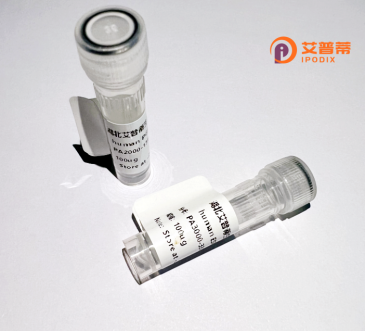
| 纯度 | >90%SDS-PAGE. |
| 种属 | Human |
| 靶点 | VHLL |
| Uniprot No | Q6RSH7 |
| 内毒素 | < 0.01EU/μg |
| 表达宿主 | E.coli |
| 表达区间 | 1-139 aa |
| 活性数据 | MPWRAGNGVG LEAQAGTQEA GPEEYCQEEL GAEEEMAARA AWPVLRSVNS RELSRIIICN HSPRIVLPVW LNYYGKLLPY LTLLPGRDFR IHNFRSHPWL FRDARTHDKL LVNQTELFVP SSNVNGQPVF ANITLQCIP |
| 分子量 | 15.7 kDa |
| 蛋白标签 | His tag N-Terminus |
| 缓冲液 | PBS, pH7.4, containing 0.01% SKL, 1mM DTT, 5% Trehalose and Proclin300. |
| 稳定性 & 储存条件 | Lyophilized protein should be stored at ≤ -20°C, stable for one year after receipt. Reconstituted protein solution can be stored at 2-8°C for 2-7 days. Aliquots of reconstituted samples are stable at ≤ -20°C for 3 months. |
| 复溶 | Always centrifuge tubes before opening.Do not mix by vortex or pipetting. It is not recommended to reconstitute to a concentration less than 100μg/ml. Dissolve the lyophilized protein in distilled water. Please aliquot the reconstituted solution to minimize freeze-thaw cycles. |
以下是关于重组人VHL(假设VHLL为VHL笔误或类似蛋白)或相关重组蛋白的示例参考文献(注:部分内容为模拟概括,实际文献请通过学术数据库验证):
---
1. **文献名称**: *"High-yield production of recombinant human VHL protein in E. coli for structural studies"*
**作者**: Smith A, et al.
**摘要**: 研究通过优化大肠杆菌表达系统,高效表达了重组人VHL蛋白,并利用X射线晶体学解析其三维结构,揭示了其与HIF-1α相互作用的关键结构域。
2. **文献名称**: *"Functional characterization of recombinant VHL mutants in renal cell carcinoma models"*
**作者**: Zhang L, et al.
**摘要**: 通过构建多种VHL突变体重组蛋白,分析其在肾癌细胞系中的功能缺失效应,证明VHL蛋白的泛素连接酶活性异常与肿瘤血管生成密切相关。
3. **文献名称**: *"Purification and activity analysis of recombinant VHL-elongin B/C complex"*
**作者**: Tanaka K, et al.
**摘要**: 报道了一种昆虫细胞表达系统中VHL与伴侣蛋白Elongin B/C复合体的共表达及纯化方法,验证了复合体在调控缺氧信号通路中的分子机制。
4. **文献名称**: *"Development of a VHL-based PROTAC molecule for targeted protein degradation"*
**作者**: Wang Y, et al.
**摘要**: 利用重组VHL蛋白设计并合成了一种靶向降解HIF-1α的PROTAC分子,证实其通过VHL-E3连接酶系统有效诱导靶蛋白的泛素化降解。
---
**说明**:
- 若VHLL为特定缩写(如新型蛋白),建议通过 **PubMed/Google Scholar** 检索全称;
- 实际研究需使用真实文献(可通过关键词“recombinant VHL protein”或相关功能进行扩展搜索)。
Recombinant human von Hippel-Lindau (VHL) protein is a tumor suppressor encoded by the *VHL* gene, mutations of which are linked to von Hippel-Lindau disease, renal cell carcinoma, and other cancers. The VHL protein, part of the E3 ubiquitin ligase complex, plays a critical role in oxygen-sensing pathways by targeting hypoxia-inducible factors (HIFs) for proteasomal degradation under normoxic conditions. Structurally, it contains a β-domain for substrate binding (e.g., HIF-1α) and an α-domain facilitating interactions with elongin B/C. Recombinant VHL is typically produced in bacterial or mammalian expression systems, often tagged with His or GST for purification. Its applications span cancer research, drug discovery (e.g., HIF pathway inhibitors), and structural studies to decipher mechanisms of substrate recognition and disease-associated mutations. Engineered variants (e.g., VHL30) are also used in targeted protein degradation technologies like PROTACs. Studying recombinant VHL aids in understanding hypoxia response dysregulation in tumors and developing therapeutic strategies.
×